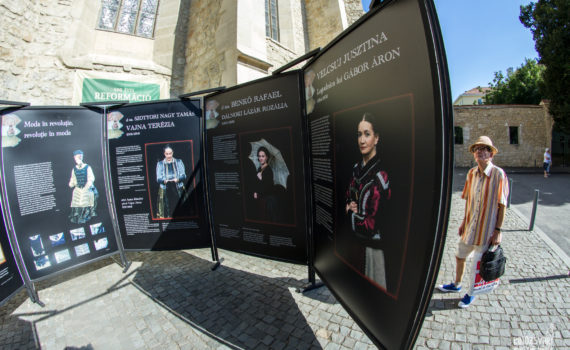
A walk in the downtown of Cluj/Kolozsvár these days will give you the opportunity to find out less familiar details about the architecture of the town, to get acquinted with the brave women of the old county of Trei Scaune/Háromszék (County Covasna/Kovászna) and to remember some of the special moments of the previous 10 editions of the Hungarian Cultural Days of Cluj/Kolozsvár. And all of the aforementioned can be accomplished if you visit the three open-air exhibitions placed onto The Unirii Square and The Calvin Square (in front of the Reformed Church in the Mihail Kogălniceanu Street (Farkas utca in Hungarian).
Outlaid on 25 panels between the statue of King Matthias Corvinus and the Saint Michael’s Church, the photo exhibition is there to celebrate the previous editions of the Hungarian Cultural Days in Cluj/Kolozsvár as it shows images proving the organic development process of the festival, as well as its impact on the local community. And because it is not really awesome to celebrate alone, other similar festivals of the Transylvanian Hungarian communities have been invited, such as The Hungarian Cultural Days in Braşov/Brassó, The Hungarian Days in Dej/Dés, The Hungarian Days in County Hunedoara/Hunyad, The Whirl in Târgu-Mureş/Marosvásárhely, The Főtér Festival – The Hungarian Days in Baia Mare/ Nagybánya, The Hungarikum Days in Sibiu/Nagyszeben, The Hungarian Days in County Alba/Fehér, The Saint Ladislaus’ Days in Oradea/Nagyvárad, The Hungarian Cultural Days in the Partium (Satu Mare/Szatmár) and the Gungarian Cultural Days in Timişoara/Temesvár.
Also in the Unirii Square but closer to the entrance of the St. Michael’s Church, one can visit the exhibition entitled “The Architecture of Cluj/Kolozsvár Throughout the Centuries”, which makes a relevant timeline of the most important architectural monuments, starting from the first contours of the in settlement today and to the changes produced up until the mid 20th century. Therefore, passers-by may find out when the first medieval fortress was built in Cluj/Kolozsvár, when the construction of Saint Michael’s Church started and how long it took to finish it, which the most representative baroque monuments in Cluj/Kolozsvár are, when the first neo-classical buildings started being erected in the town etc. The exhibition is an architectural time-tunnel, absolutely worthwhile seeing as short, however, interesting, as it is.
The third open-air exhibition is entitled “Women of county Trei Scaune/Háromszék” and it is situated into the Calvin Square, on the lef-hand side of the entrance into the Reformed Church in the Mihail Kogălniceanu Street (Farkas utca in Hungarian). This is an exhibition meant to cherish those Hungarian women who – besides taking care of their families and households – got involved and supported the Revolution in 1848 to the best of their abilities. They were daughters of our nation, devoted to their homeland, who organized fundraising events, manufactured wicks, cast bullets, helped their husbands in the camps and even fought on their sides, firearms in hand. Their stories have been preserved by history, as well as by the collective memory as landmarks for courage, patriotism and self-sacrifice. The exhibitions are there for the visitors to see and admire all throughout the Festival.






